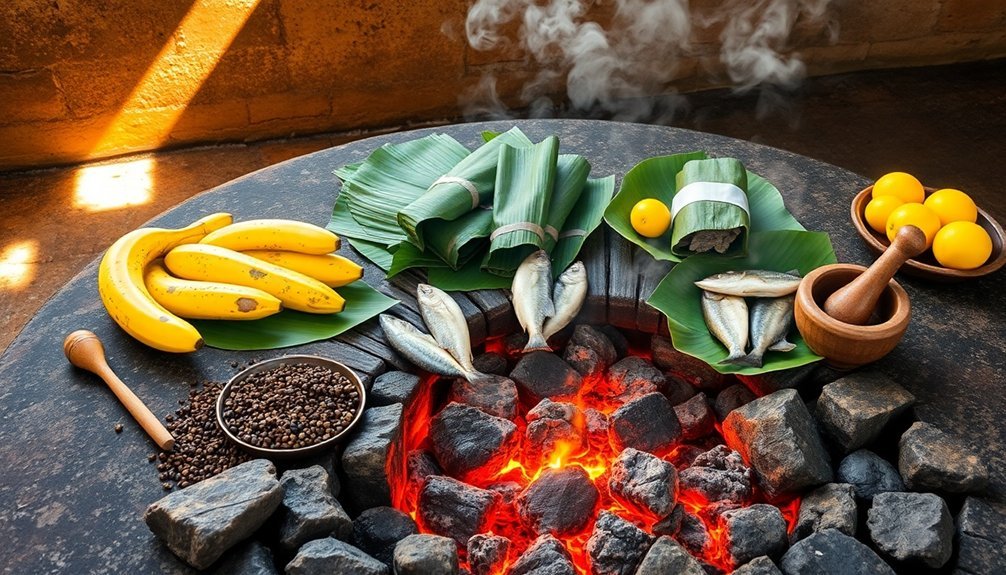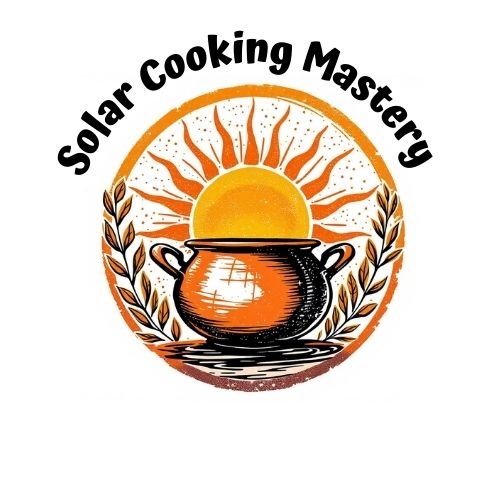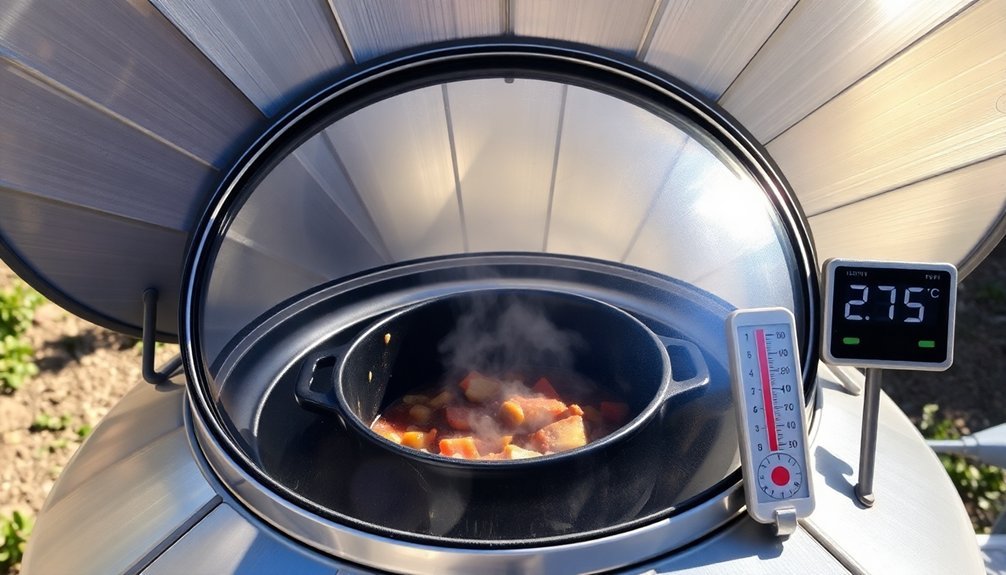You'll find five effective outdoor cooking methods perfectly suited for equatorial regions. Direct sun cooking with box or parabolic cookers harnesses abundant solar energy. A foil-wrapped pizza box setup creates a simple solar oven for basic meals. Open fire grilling offers versatility through direct heat, indirect cooking, spit-roasting, and smoke infusion. Traditional earth ovens provide slow, moisture-retaining heat while conserving fuel. An outdoor stone cooking platform delivers a permanent solution for regular outdoor meal preparation. Each method taps into natural resources and sustainable practices, with detailed techniques waiting to enhance your outdoor cooking experience.
Direct Sun Cooking Methods

While traditional cooking methods rely on fire or electricity, direct sun cooking harnesses solar energy through specialized equipment like box and parabolic cookers.
You'll find box cookers are easier to build and maintain, making them ideal for cooking vegetables, grains, and legumes at temperatures below 200°C. Parabolic cookers offer higher temperatures but require precise sun tracking and more complex construction. Studies show annual fuel savings of 30-40% when switching to solar cooking methods.
For successful solar cooking, you'll need direct sunlight between 11:00 am and 3:00 pm. Your cooking times will typically double compared to conventional methods – vegetables and grains take about 2 hours, while legumes need 3 hours.
A glass or Plexiglas cover traps heat like a greenhouse, and proper insulation keeps the energy inside. You'll achieve temperatures between 200-300°F, sufficient for safely cooking most dishes.
Foil-Wrapped Solar Food Preparation
When creating a foil-wrapped solar oven, you'll need basic household materials like a pizza box, aluminum foil, and plastic wrap to harness the sun's energy effectively.
Start by cutting a flap in the pizza box's top, leaving one edge as a hinge. Cover the flap's inside with foil for reflection.
You'll want to insulate the box's interior with newspaper, then add black construction paper to absorb heat. Cover the flap's opening with plastic wrap, sealing it tightly to keep heat inside.
Place your food in the center and position the oven in direct sunlight. This method promotes hands-on learning experiences while demonstrating scientific principles in action.
Don't forget to adjust the foil flap throughout cooking to maximize sunlight reflection. Keep track of the temperature using a thermometer, and make sure you're following food safety guidelines while the sun does its work.
Open Fire Grilling Techniques

Mastering open fire grilling requires understanding four distinct techniques: direct grilling, indirect grilling, spit-roasting, and smoke infusion.
Each method serves specific cooking needs and helps you achieve different flavor profiles.
- Direct grilling works best for quick-cooking cuts, placing your food right over high heat for 3-6 minutes per side.
- Indirect grilling uses a two-zone setup, perfect for larger cuts like whole chickens, with the food placed adjacent to the heat source.
- Spit-roasting and cruz methods excel at slow-roasting large cuts with skin on, creating crispy exteriors while maintaining moisture.
- Smoke infusion lets you add complex flavors by strategically placing wood chips around your coals.
You'll want to match your technique to your ingredients.
Use hardwoods like quebracho for authentic smoky flavors, and don't forget to use drip pans when needed.
For optimal results, maintain a proper heat and smoke balance by managing your fire consistently throughout the cooking process.
Earth Oven Traditional Cooking
Traditional earth oven cooking offers four key advantages over modern methods: superior moisture retention, enhanced flavor development, energy efficiency, and hands-off cooking.
You'll start by digging a pit 12-24 inches wide and 9-20 inches deep in a safe area away from flammable materials.
After building a fire to heat rocks or coals, you'll place them at the pit's bottom. Wrap your food in banana leaves or foil, arrange hot cooking stones around it, and cover everything with soil and leaves to trap heat.
While cooking times vary from hours to a full day, you won't need to monitor the process constantly. This method's slow, even heat distribution preserves natural juices and flavors while using minimal firewood, making it perfect for cooking large quantities of food in equatorial regions.
Outdoor Stone Cooking Platform

While earth ovens excel at traditional cooking, a permanent outdoor stone cooking platform brings modern convenience to equatorial food preparation.
You'll need to start with proper foundation work by excavating the area and creating a solid concrete base pad reinforced with rebar.
For the most durable and weather-resistant platform, consider these essential elements:
- Use CMU blocks as your substrate, ensuring they're perfectly level on the concrete base
- Install utility conduits for gas, electric, and water before constructing the base pad
- Choose either natural stone or cultured stone panels for the exterior finish
- Apply high-quality masonry adhesive between all components for stability
Remember to plan your layout carefully using appliance templates and include adequate counter space for food prep.
The platform's design should accommodate your specific cooking needs while withstanding tropical conditions.
Frequently Asked Questions
How Do You Prevent Insects From Contaminating Food During Outdoor Cooking?
You'll need to cover food with lids, set up fans for airflow, use citronella products, keep food in sealed containers, and place natural repellents like basil or citrus peels around your cooking area.
What Alternative Outdoor Cooking Methods Work During Rainy Seasons?
You'll find steaming and cooking en papillote work great in rain. Use a tarp-covered Dutch oven, mug cooking with tight lids, or try one-pot freezer bag methods while keeping gear protected from moisture.
Can Traditional Succotash Be Prepared Using Wild-Foraged Ingredients?
Yes, you can make authentic succotash by foraging wild ingredients like corn, beans, and wild game. You'll need to gather edible plants, process corn into hominy, and combine them with foraged herbs and meats.
Which Local Leaves Are Safe for Wrapping Food During Outdoor Cooking?
You'll find banana, fig, and grape leaves are safe choices for food wrapping. If you're foraging locally, look for corn husks, bamboo leaves, or cattail leaves – just confirm they're clean and pesticide-free.
How Long Can Prepared Food Safely Remain Outdoors in Tropical Temperatures?
You shouldn't leave food in tropical temperatures for more than 2 hours. If it's above 93°F, you've got just 1 hour before you'll need to refrigerate, consume, or discard the food for safety.
In Summary
You've learned five practical ways to cook delicious meals in equatorial regions using only outdoor methods. Whether you're trying solar cooking, wrapping food in foil, grilling over an open flame, using an earth oven, or cooking on heated stones, you'll find these traditional techniques both effective and energy-efficient. Now you're ready to put these methods to use and create flavorful dishes while embracing sustainable outdoor cooking practices.





Leave a Reply